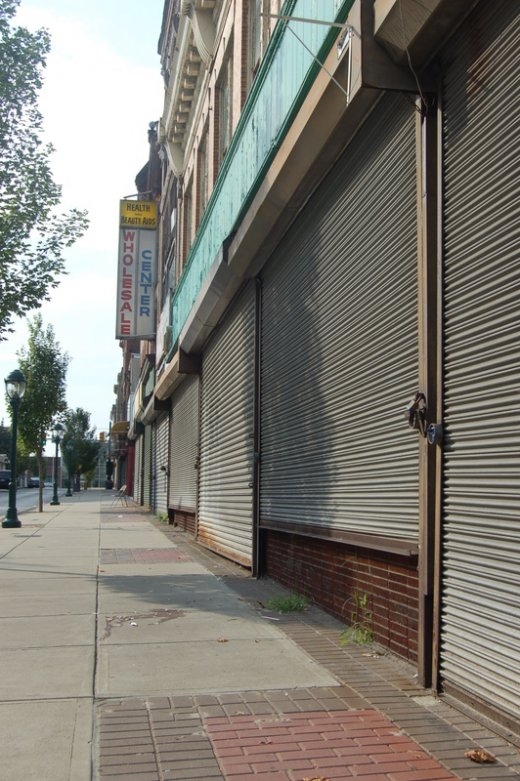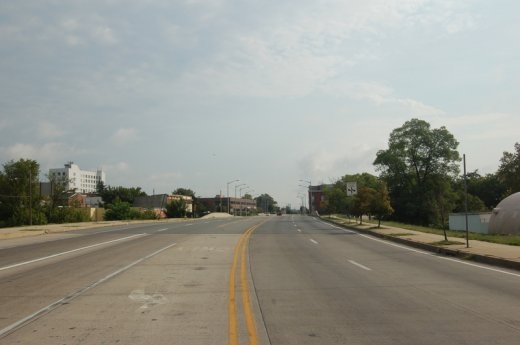[Photos by JEFF DEENEY]
 BY JEFF DEENEY For the next few weeks, the focus of Valley of the Shadow will shift to Chester, Delaware County. In 2008, Philadelphia experienced a significant reduction in homicides. That has not been the case in Chester. In fact, this month Chester saw six homicides in a single week, which for a city of only 35,000 is a staggering number. Before starting in on a series about Chester I sat down with someone acquainted with the city’s underworld, a former junkie and mid-level Delco drug runner called Cupcake. Cupcake spent the better part of 10 years in Chester buying weed and coke that he in turn took to the greener pastures of Nether Providence, and turned a pretty profit supplying the privileged kids at Strath Haven High School and later at Swarthmore College fraternity parties full of Polo-sweatered silver spooners. Cupcake had family living in Chester’s notorious Bennett Homes (now Matapos Hills), so he had a foot on either side of the tracks, so to speak.
BY JEFF DEENEY For the next few weeks, the focus of Valley of the Shadow will shift to Chester, Delaware County. In 2008, Philadelphia experienced a significant reduction in homicides. That has not been the case in Chester. In fact, this month Chester saw six homicides in a single week, which for a city of only 35,000 is a staggering number. Before starting in on a series about Chester I sat down with someone acquainted with the city’s underworld, a former junkie and mid-level Delco drug runner called Cupcake. Cupcake spent the better part of 10 years in Chester buying weed and coke that he in turn took to the greener pastures of Nether Providence, and turned a pretty profit supplying the privileged kids at Strath Haven High School and later at Swarthmore College fraternity parties full of Polo-sweatered silver spooners. Cupcake had family living in Chester’s notorious Bennett Homes (now Matapos Hills), so he had a foot on either side of the tracks, so to speak.
Fully understanding the story of Chester requires stepping back and placing it within the larger framework of Delaware County, which became increasingly well-to-do over the decades that the small city languished. There is an obvious race angle here, with Chester being 75 percent black and overwhelmingly poor and the rest of the county being 80 percent white and firmly middle class. The tony town of Wallingford is only three-and-a-half miles up the road; I’m sure a lot of Wallingford residents aren’t entirely comfortable about that, though I’m sure it’s not considered good form to say so.
Cupcake’s story of running drugs from Chester into the suburbs confirms one of Delco’s dirty secrets, that the cocaine over which poor black kids in Chester are routinely killing each other often makes its way into the noses of wealthier whites up-county who never see where their drugs really come from. Cupcake also corroborated several unsavory anecdotes I’d heard growing up in Delco about sundown-town style policing, where young black men passing through white towns on foot after dark were were given a police escort to the Chester city limits. He also had personal experience with the reverse scenario, where young white kids trying to buy drugs are escorted out of Chester with a simple admonishment from the cops to stay on their side of the tracks from now on.
Chester is broken down geographically into the Eastside and Westside; it’s hard to say which is worse because both are pretty thoroughly decimated. Chester currently has a population that’s roughly half of what it was at its peak in the 1950s, and the number of crumbling, abandoned houses that can be found on just about every block reflects this exodus. The Westside sprawls a little more, where the Eastside is fairly condensed over a smaller area. The open spaces give the Westside a less claustrophobic feel, and it also has a greater number of blocks cared for by old heads who have been there for decades. You’ll find a lot of elaborate front yard gardens and decorated patios on the Westside. However, much of Chester’s recent violence has been concentrated on the Westside, which is also home to a number of public housing projects notorious for their high concentrations of dope and guns.
Downtown Chester looks like an archetype Rust Belt post-industrial wasteland, barely qualifying as a central business district with its collection of dollar stores and fast food restaurants. This is what Chester’s business district looks like on a typical weekday morning.

As you can tell, there’s not a lot of business happening; the lack of foot traffic and eerie silence lend the scene a post-apocalyptic feel.
Likewise, closer to the waterfront, along Route 291, there are few signs of life. This major thoroughfare was built big enough to accommodate the trucking traffic that moves between the waterfront’s industrial plants, but sees little volume even at the height of rush hour.

It’s hard to imagine leisurely standing around in the middle of a major road feeding a city’s waterfront and business district at 9 on a Monday morning, but as you can tell there’s not much risk involved when that road is Route 291 and the city in question is Chester.
Cupcake made a powerful point while discussing the changes Chester went through during its downfall. “The problem is when everyone left they came in and Section 8-ed the whole place. Even Camden’s got nice neighborhoods. Chester’s got nothing.”
Camden has the Rutgers campus, the Adventure Aquarium, the Susquehanna Bank Center, Battleship New Jersey, the baseball stadium. There is no destination neighborhood in Chester, and its only attraction is Harrah’s Chester, a nickel-and-dime slot parlor safely removed from the city center on a remote stretch of industrial waterfront. Camden’s recent developments still aren’t enough for the city to turn the corner yet, and its reputation for drugs and violent crime is notorious, but there is a glimmer of hope. There seems no glimmer of hope for Chester. I’m sure there are some who disagree, but based on what I’ve seen I think there’s little reason for optimism.
Next week Valley of the Shadow will start off its Chester series on the Eastside, where they sell angel dust and crack rocks and a lot of bodies are dropped all within a stone’s throw of the new casino that was supposed be the impetus for big changes in little Chester, where, like I’ve said before, nothing seems to change except to decay.
ABOUT THE AUTHOR: Jeff Deeney is a freelance writer whose work has appeared in PW, City Paper and the Inquirer. He focuses on issues of urban poverty and drug culture. He is currently working on a book about life in the crossfire of poverty, drugs, guns, and the bureaucracies designed to remedy them, all of which informed his experiences as social workers in some of the city’s most dire and depleted neighborhoods.
